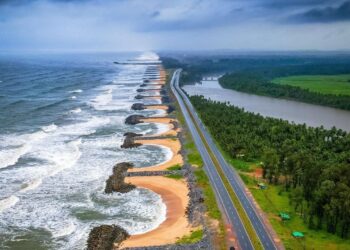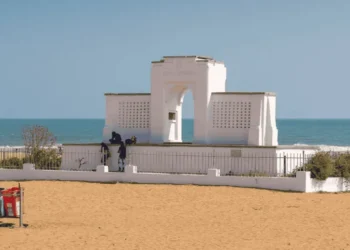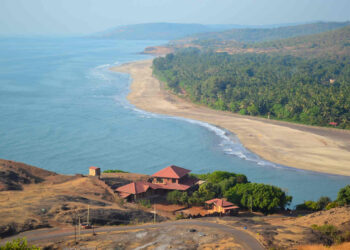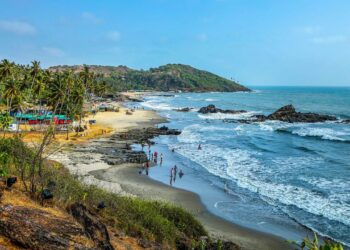Located in East Champaran, Bihar, close to the Gandak River, the Viraat Ramayan Mandir is a prominent pilgrimage site for devotees of Lord Rama and Goddess Sita. Visitors believe that sincere worship here brings divine blessings and helps fulfill their wishes. The under-construction shrine honors the entire Ramayana story, with idols of Rama, Sita, Lakshmana, and Hanuman, and it’s seen as a modern marvel inspired by ancient epics. Where Rama resides, his blessings bring prosperity and peace.
History of Viraat Ramayan Mandir
The Viraat Ramayan Mandir is a modern temple project, first proposed in 2012 by the Mahavir Mandir Trust of Patna. Construction began in June 2023, after Acharya Kishore Kunal laid the foundation. Located in East Champaran, a region linked to the Ramayana and near the Valmiki Ashram, the temple sits on 161 acres of flat land in the villages of Kaithwalia and Bahuara, making it easily accessible from the highway.
The site was chosen to honor Mithila’s connection to Sita, the birthplace of the goddess, and the temple is fully funded by the trust with a budget of ₹500 crore, constructed by Tata in partnership with Suntech Infra. Earlier plans to build near Hajipur were changed due to land and logistical concerns. In 2013, Bihar CM Nitish Kumar unveiled a model of the temple, but some delays arose, including a protest from Cambodia over an Angkor Wat replica, prompting a change in design and name.
Architecture of Viraat Ramayan Mandir
The Viraat Ramayan Mandir is designed in a grand Nagara style with hints of Southeast Asian influence, large in scale yet spiritually rich. Constructed using stone and modern materials, it aims to be both timeless and sturdy. The main sanctum, dedicated to Lord Rama and Sita, will feature detailed carvings depicting scenes from the Ramayana. A side temple will house what is planned as the world’s largest Shivling, along with 18 smaller shrines for figures like Hanuman and Ravana. The temple’s dimensions are set at 1,080 ft long, 540 ft wide, and 270 ft high, with a central spire even taller than Ayodhya’s Ram Mandir, capped with kalashas on multiple shikharas.
The temple complex covers about 161 acres and is built with wide layered floors instead of tall multi-storey buildings. The first layer itself goes over a kilometer, with electronic displays showing stories from the Ramayana and small temples with spires at the corners. The main entrance gopuram will have detailed paintings of Lord Rama’s life, and the walls all around are carved with scenes from the epic, giving a sacred feel. There is a huge hall that can hold around 20,000 people for kirtans, and gardens around it provide quiet spots for reflection. Right now, the plinth is built up to 26 feet, and the shikharas will be added in the last phase. The design is meant to feel grand but stay traditional, not overly flashy.
Legends of Viraat Ramayan Mandir
The temple takes inspiration from Ramayana tales cherished by locals. One well-known story is the epic itself, Rama’s exile, Sita’s abduction, and the eventual defeat of Ravana, which is said to influence the temple’s location in Mithila, Sita’s birthplace near King Janaka’s realm. The name Viraat, meaning “grand,” is believed to bring blessings for family harmony, success, or health to devotees who pray with devotion.
Another legend connects to sage Valmiki composing the Ramayana in the forests of Champaran, giving the area additional sacredness. Locals speak of miracles to come once the temple opens, peace in troubled times or guidance in life. The planned Shivling is said to hold Rama’s protective energy, and some believe that circumambulating the complex seven times can make wishes come true. During Ram Navami, devotees feel the spiritual presence and Rama’s energy will be especially strong here.
How to Get There
Air: Jay Prakash Narayan Airport in Patna is about 120 km away, with flights connecting to Delhi (around 1 hour) and Kolkata (around 1 hour). Taxis take approximately 3 hours to reach the temple.
Train: Motihari Station is 31 km south, with trains to Patna (about 4 hours) and Muzaffarpur (about 2 hours). Auto-rickshaws available for local travel.
Road: The site’s 31 km north of Motihari via Kesaria-Chakia road, 120 km from Patna on NH-28A. Buses run from Patna and Motihari. Autos operate in the area. Parking space limited, no spot right at the complex yet.
Best Time to Visit
October to March is cool, 15–25°C. Weekdays quiet. Ram Navami and Diwali busy, with thousands expected, so come early.
Nearby Attractions
Kesariya Stupa: 5 km away, ancient Buddhist ruins from 3rd century BC.
Valmiki Ashram: 50 km away, where Valmiki wrote Ramayana, near Gandak River.
Motihari Gandhi Memorial: 31 km away, spot of Champaran Satyagraha.











